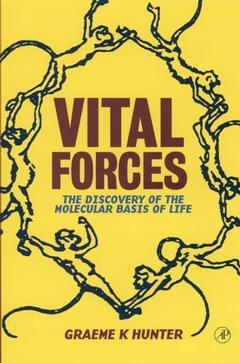Description
Vital Forces
The Discovery of the Molecular Basis of Life
Author: Hunter Graeme K.
Language: English
Subject for Vital Forces:
Publication date: 11-2000
364 p. · 15x22.8 cm
Out of Print
364 p. · 15x22.8 cm
Out of Print
Description
/li>Contents
/li>Readership
/li>Biography
/li>Comment
/li>
Combining science and biography into a seamless chronological narrative, the author of Vital Forces brings to life the successes and failures, collaborations and feuds, and errors and insights that produced the revolution in biology. The story is told in a clear, engaging, and absorbing manner. This delightful work relates the fascinating and staggering advances in concepts and theories over the last 200 years and introduces the major figures of the times.
List of Plates.
Preface.
Acknowledgements.
The Revolution in Chemistry Has Come to Pass.
The Maze of Organic Chemistry.
A Singular Inward Laboratory.
The Catalytic Force.
Building Stones of Protoplasm.
The Chemical and Geometrical Phenomena of Heredity.
The Megachemisry of the Future.
The Giant Molecules of the Living Cell.
The Chemical Basis of Genetics.
The Heredity Code-script.
The Ubiquitous Spiral.
Our Thread of Ariadne.
Nature is Blind and Reads Braille.
References.
Selected Readings in the History of Biochemistry and Molecular Biology.
Name Index.
Subject Index.
Preface.
Acknowledgements.
The Revolution in Chemistry Has Come to Pass.
The Maze of Organic Chemistry.
A Singular Inward Laboratory.
The Catalytic Force.
Building Stones of Protoplasm.
The Chemical and Geometrical Phenomena of Heredity.
The Megachemisry of the Future.
The Giant Molecules of the Living Cell.
The Chemical Basis of Genetics.
The Heredity Code-script.
The Ubiquitous Spiral.
Our Thread of Ariadne.
Nature is Blind and Reads Braille.
References.
Selected Readings in the History of Biochemistry and Molecular Biology.
Name Index.
Subject Index.
Molecular biologists, protein chemists, biochemists, chemists and physicists, life scientists and all those with an interest in the history and development of the field
Graeme Hunter studied biochemistry at the University of Glasgow, graduating with the degree of Ph.D. in 1980. He carried out post-doctoral research at Stanford University and the University of Toronto. In 1988, Dr. Hunter became an Assistant Professor in the Department of Oral Biology at the University of Alberta. Since 1991, he has held the position of Associate Professor in the Faculty of Medicine & Dentistry at the University of Western Ontario.Dr. Hunter's current research interests are in the areas of biomineralizatin and the history and philosophy of biology.
- Vividly describes dramatic scientific discoveries, personalities, feuds and rivalries
- Answers a general readers quest to understand the nature of life, and the relevance of biochemistry/molecular biology to modern medicine, industry and agriculture
© 2024 LAVOISIER S.A.S.

